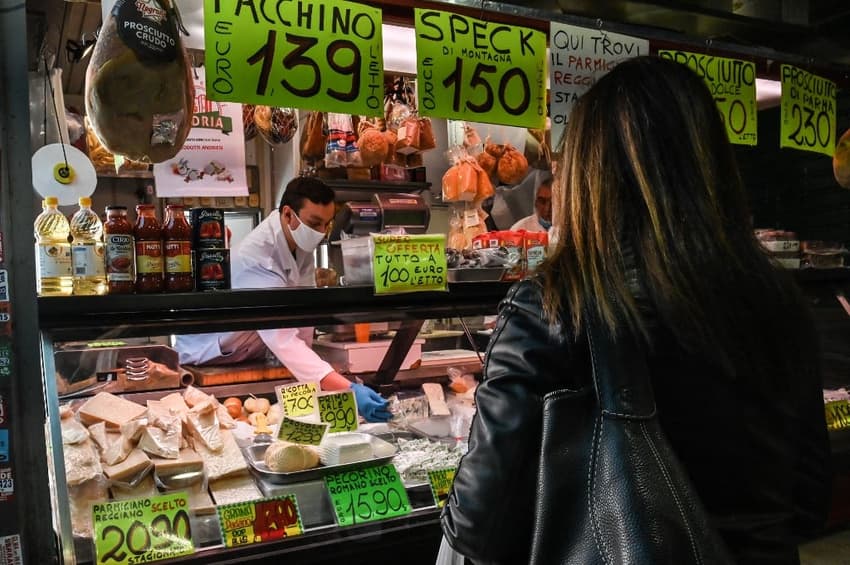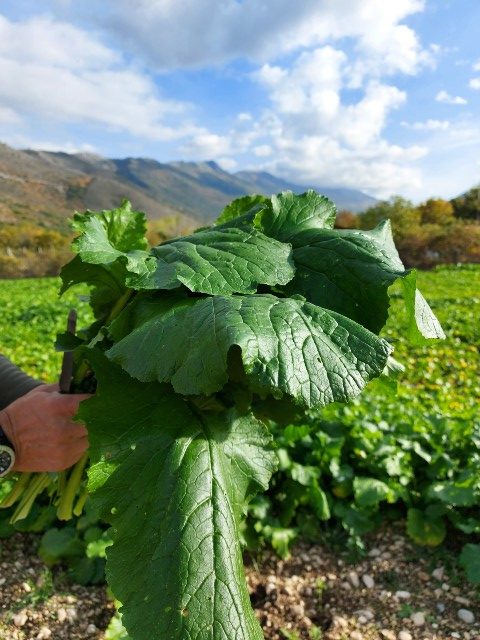From fried brains to 'sexy' cakes: The Italian foods you might not expect in Italy

Italy may be known worldwide for pizza and gelato, but some delicacies loved by Italians are a lot less appetising to foreign visitors, as reporter Silvia Marchetti explains.
Tagliatelle, lasagne, spaghetti alla carbonara and gelato are the iconic foods foreigners visiting Italy can’t wait to indulge in. They symbolize Italian cuisine worldwide and everybody knows them.
There is this widespread belief that Italian dishes are mostly sophisticated recipes, beautiful to look at as if out of a glossy gourmand magazine.
But there are many peculiar foods newcomers will be amazed - if not shocked - to find in Italy.
We eat baby rabbits and piglets in all sorts of ways. Roman coniglio alla cacciatore (rabbit cooked in wine, the huntsmans' way) and Sardinian porceddu are local specialities, even though just the thought will put many people off. Piglets in many Sardinian towns are still cooked the old way, skewered on bonfires with a crunchy outer skin sweetened by drops of their blood.
I know from experience Brits and Americans do not eat rabbits, which are pets for them just like cats and dogs. For Italians, they’re succulent meat.
I discovered this culinary clash at high school, when during pyjama parties I would see cute bunnies scurrying across the floor and tell my friends my mom made delicious rabbit dishes. I was accused of being a ‘cannibal’.
Alpine restaurants serve deer and chamois cold cuts and fillets, which I have tasted and must admit are delicious. Finding Bambi on your plate can be quite shocking for travellers visiting Italy for the first time, likewise finding horsemeat delicacies in some regions.
In Rome locals adore pajata which looks and is quite gruesome: the interior of a calf’s intestine, full of white soft excrements given the baby has only fed on its mother’s milk. When I go to the butcher’s shop near my house I see customers buying portions of coratella (cow heart, liver, brain) and bovine tongues.
In Tuscany all menus feature paté di fegatini, little chicken livers spread on bruschetta or crostini, alongside trays of fried brains, livers of various animals and cows’ stomach, or lampredotto. The ‘boccone del prete’ (the priest’s morsel) is the most sublime part of the chicken: its rectum.
In some deep rural areas in Puglia, farmhouses make sanguinaccio for breakfast like their ancestors did: mixing dark melted chocolate with fresh pig blood from their pigsty.
When it comes to fish, Sardinia’s bottarga cured roe sack is the most bizarre. It is eaten both grated like parmiggiano or as sliced pieces of dried ovaries on salads, bruschetta and spaghetti.
Last time I visited the Aeolian islands I tasted paccheri pasta with the eggs of minnole, little fish fresh from their mother’s belly, cut open by fishermen at the morning market. Sicilians have a knack for diving into the water and coming back up with a handful of sea urchins which they cut open with a knife and eat raw. I tried one but the pungent taste doesn’t agree with my palate.
READ ALSO:
- Why Michelin-starred cuisine is just not suited to Italy
- Want to eat well in Italy? Here’s why you should ditch the cities
- How to spot the Italian restaurants to avoid
Veggies are also tricky. Even what most foreigners would consider to be weeds, brushwood or simple grass is eaten in Italy. My granny had a saying: non si butta niente e tutto fa brodo, (nothing is thrown away and it all makes broth - ie. it’s all good).
Romans on weekends go hunting with gloves for wild nettles in the countryside to sprinkle on a dish of pasta or make a pesto-like sauce. They’re also very fond of ugly looking prickly zucchini that grow in abandoned fields, which are dubbed gratta-culi (ass scrapers) as local lore tells us picnickers who go looking for an open-air toilet could get their buttocks pricked.
On southern islands restaurant menus feature algae dishes with finocchietto marino (sea fennel that grows on rocks on the water surface). In remote Abruzzo villages farmer sell crema di mugnoli, huge broccoli leaves pressed into pasta sauce.

Abruzzo’s mugnoli. Photo: Borghi piu belli d’Italia
My family loves pizza with fiori di zucca or fiori di zucchina (pumpkin and zucchini flowers), while my father’s favorite veggie is called barba di frate (friar’s beard) or agretti, with long thin foliage resembling the hair of a long beard.
In Val di Comino, north of Naples, people forage for a type of small spinach called orapi, which grows underneath fertile goat dung, making it particularly tasty - and expensive at restaurants. My Tuscan aunt used to roam the prairies for mallow flowers and boraggine (borage) to make omelettes.
There are also shockingly sexy deserts that might seem to clash with Italy’s deeply Catholic traditions, but which in fact aren’t blasphemous at all.
In southern regions including in Naples and Sicily locals indulge in so-called zizze di monaca (nun’s breasts) or minne di virgini (virgin’s breasts) that are indeed shaped like women's breasts, covered in icing and topped with cherries that resemble nipples.
In Catania these are prepared each winter to honor the martyrdom of Saint Agatha whose breasts were cut off by a cruel ancient Roman official. While In the Sicilian town of Sambuca the minne, slightly different, are a daily treat.

Sambuca’s minne di virgini. Photo: Silvia Marchetti
There are also the sospiri di suora (nun’s sighs), small buns that nod to the extreme ecstatic pleasure one has in eating them. The ‘sighs’ may have a sexual connotation related to orgasm, but even though southerners are very pious they actually think these treats pay homage to spirituality. Ecstasy after all can be a carnal or mystical experience.
When it comes to food, Italians have no limits.
Comments
See Also
Tagliatelle, lasagne, spaghetti alla carbonara and gelato are the iconic foods foreigners visiting Italy can’t wait to indulge in. They symbolize Italian cuisine worldwide and everybody knows them.
There is this widespread belief that Italian dishes are mostly sophisticated recipes, beautiful to look at as if out of a glossy gourmand magazine.
But there are many peculiar foods newcomers will be amazed - if not shocked - to find in Italy.
We eat baby rabbits and piglets in all sorts of ways. Roman coniglio alla cacciatore (rabbit cooked in wine, the huntsmans' way) and Sardinian porceddu are local specialities, even though just the thought will put many people off. Piglets in many Sardinian towns are still cooked the old way, skewered on bonfires with a crunchy outer skin sweetened by drops of their blood.
I know from experience Brits and Americans do not eat rabbits, which are pets for them just like cats and dogs. For Italians, they’re succulent meat.
I discovered this culinary clash at high school, when during pyjama parties I would see cute bunnies scurrying across the floor and tell my friends my mom made delicious rabbit dishes. I was accused of being a ‘cannibal’.
Alpine restaurants serve deer and chamois cold cuts and fillets, which I have tasted and must admit are delicious. Finding Bambi on your plate can be quite shocking for travellers visiting Italy for the first time, likewise finding horsemeat delicacies in some regions.
In Rome locals adore pajata which looks and is quite gruesome: the interior of a calf’s intestine, full of white soft excrements given the baby has only fed on its mother’s milk. When I go to the butcher’s shop near my house I see customers buying portions of coratella (cow heart, liver, brain) and bovine tongues.
In Tuscany all menus feature paté di fegatini, little chicken livers spread on bruschetta or crostini, alongside trays of fried brains, livers of various animals and cows’ stomach, or lampredotto. The ‘boccone del prete’ (the priest’s morsel) is the most sublime part of the chicken: its rectum.
In some deep rural areas in Puglia, farmhouses make sanguinaccio for breakfast like their ancestors did: mixing dark melted chocolate with fresh pig blood from their pigsty.
When it comes to fish, Sardinia’s bottarga cured roe sack is the most bizarre. It is eaten both grated like parmiggiano or as sliced pieces of dried ovaries on salads, bruschetta and spaghetti.
Last time I visited the Aeolian islands I tasted paccheri pasta with the eggs of minnole, little fish fresh from their mother’s belly, cut open by fishermen at the morning market. Sicilians have a knack for diving into the water and coming back up with a handful of sea urchins which they cut open with a knife and eat raw. I tried one but the pungent taste doesn’t agree with my palate.
READ ALSO:
- Why Michelin-starred cuisine is just not suited to Italy
- Want to eat well in Italy? Here’s why you should ditch the cities
- How to spot the Italian restaurants to avoid
Veggies are also tricky. Even what most foreigners would consider to be weeds, brushwood or simple grass is eaten in Italy. My granny had a saying: non si butta niente e tutto fa brodo, (nothing is thrown away and it all makes broth - ie. it’s all good).
Romans on weekends go hunting with gloves for wild nettles in the countryside to sprinkle on a dish of pasta or make a pesto-like sauce. They’re also very fond of ugly looking prickly zucchini that grow in abandoned fields, which are dubbed gratta-culi (ass scrapers) as local lore tells us picnickers who go looking for an open-air toilet could get their buttocks pricked.
On southern islands restaurant menus feature algae dishes with finocchietto marino (sea fennel that grows on rocks on the water surface). In remote Abruzzo villages farmer sell crema di mugnoli, huge broccoli leaves pressed into pasta sauce.

My family loves pizza with fiori di zucca or fiori di zucchina (pumpkin and zucchini flowers), while my father’s favorite veggie is called barba di frate (friar’s beard) or agretti, with long thin foliage resembling the hair of a long beard.
In Val di Comino, north of Naples, people forage for a type of small spinach called orapi, which grows underneath fertile goat dung, making it particularly tasty - and expensive at restaurants. My Tuscan aunt used to roam the prairies for mallow flowers and boraggine (borage) to make omelettes.
There are also shockingly sexy deserts that might seem to clash with Italy’s deeply Catholic traditions, but which in fact aren’t blasphemous at all.
In southern regions including in Naples and Sicily locals indulge in so-called zizze di monaca (nun’s breasts) or minne di virgini (virgin’s breasts) that are indeed shaped like women's breasts, covered in icing and topped with cherries that resemble nipples.
In Catania these are prepared each winter to honor the martyrdom of Saint Agatha whose breasts were cut off by a cruel ancient Roman official. While In the Sicilian town of Sambuca the minne, slightly different, are a daily treat.

There are also the sospiri di suora (nun’s sighs), small buns that nod to the extreme ecstatic pleasure one has in eating them. The ‘sighs’ may have a sexual connotation related to orgasm, but even though southerners are very pious they actually think these treats pay homage to spirituality. Ecstasy after all can be a carnal or mystical experience.
When it comes to food, Italians have no limits.
Join the conversation in our comments section below. Share your own views and experience and if you have a question or suggestion for our journalists then email us at [email protected].
Please keep comments civil, constructive and on topic – and make sure to read our terms of use before getting involved.
Please log in here to leave a comment.